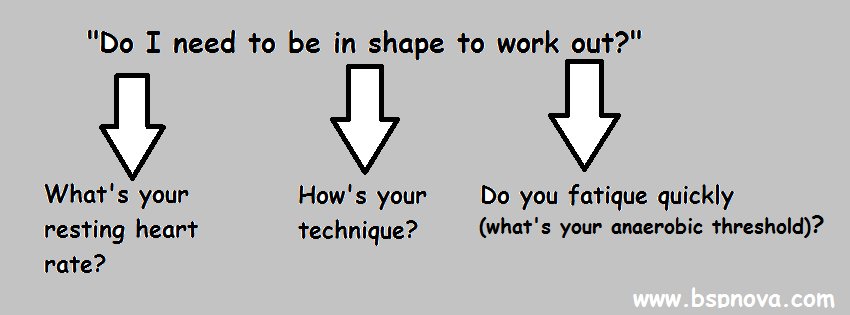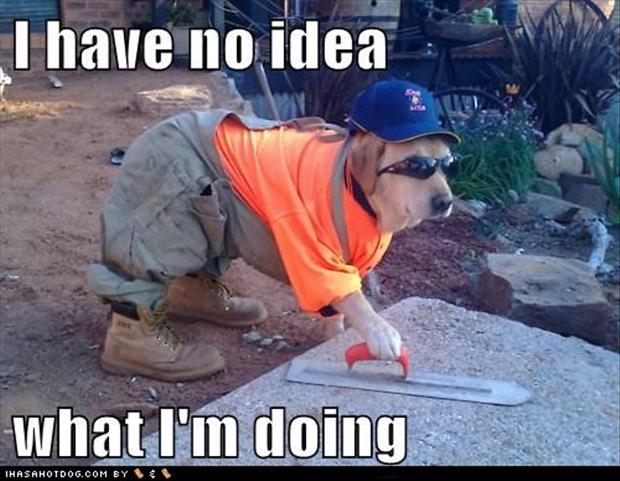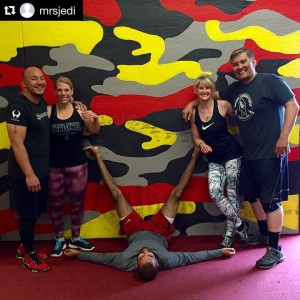I can’t even begin to tell you how many times I’ve sat across from someone during a consultation, and they drop the following question:
“Do I need to be in shape before I start working out?”
And a few years ago, I would have unequivocally said:
“No! Why would you ask such a silly question??”
I mean, that’s why they’re here to work out… to get in shape, right? But, with a few more years under my belt, and having witnessed some pretty crazy stuff, my answer has evolved.
Allow me to me explain…
When & why you MIGHT actually need to get in better shape (for some workout approaches)

What’s your resting heart rate?

Okay, okay I don’t really expect you to know this right off the bat, but we can find out. This number is very telling of a number of things, including, but not limited to:
- The efficiency of your cardiovascular system at rest
- Stress (with data over time)
- (Potential) risk of heart attack
For general population clients, we LIKE to see average resting heart rates under 65 beats per minute, and in an ideal world under 60. Our goal for resting heart may vary greatly when it comes to athletes, and this is dependent upon the needs of their sport (i.e. long distance runner vs. speed/power athlete).
Resting heart rate is best tested with a simple heart rate monitor, first thing in the morning, in the comfort of your own home while lying down.
We’ll come back to this in a few…
Do you fatigue quickly?
Maybe, even with a decently low resting heart rate, you find that simple tasks send your heart rate through the roof, leaving you fatigued very quickly. Or maybe you have a higher resting heart rate AND you fatigue from simple tasks like walking up a flight of stairs, carrying the groceries in the house, walking the dog, and other activities of daily living. Again, this is fine, and we love to work with folks just like you, but… we’ll come back to this in a few.
We can test this with a simple protocol known as the Modified Cooper’s Test. The test, which takes a mere 6 minutes to complete, can provide us with the average heart rate where you transition from mostly aerobic supply of energy production, to mostly anaerobic supply of energy production- also known as your anaerobic threshold.
How’s your technique?
 If you’re new to the world of weight training, have taken a long hiatus, or never really had professional coaching, there’s a high likelihood that you’re a novice with exercise technique. That’s totally cool, and in fact, we LOVE to work with folks just like you! But this is an important factor in determining if you need to be in shape before embarking on a new fitness journey. Like resting heart rate, we’ll be returning to this…
If you’re new to the world of weight training, have taken a long hiatus, or never really had professional coaching, there’s a high likelihood that you’re a novice with exercise technique. That’s totally cool, and in fact, we LOVE to work with folks just like you! But this is an important factor in determining if you need to be in shape before embarking on a new fitness journey. Like resting heart rate, we’ll be returning to this…
“Okay, okay, I get it- but what’s all of this tell you about me? And what in the world does this have to do with whether I need to be in shape or not?”
Ah, I’m glad you asked! 😉 Thanks to the work of Mike Robertson, and with the above information, we can make some informed decisions.
First: Let’s look at your aerobic window…
Anaerobic Threshold — Resting Heart Rate = Aerobic Window
In the below picture, borrowed from Mike Robertson’s article, Widening the Aerobic Window, you can see that athlete A has a resting heart rate of 80 beats per minute (yikes!), and an anaerobic threshold of 160 beats per minute, making their aerobic window 80. Athlete B, on the other hand, has a resting heart of 50 beats per minute, and an anaerobic threshold of 175 beats per minute, making their aerobic window 125.

It’s safe to say that athlete B is going to be more resilient to a wide range of activities, being that they’re able to stave off fatigue, utilizing aerobic energy production for a wide variance of intensities. And because their aerobic window is so large, they’ll likely be able to come down and recover from the times they do go more anaerobic, much quicker than athlete A.
Athlete A will feel fatigued much quicker, have a harder time recovering (both intra-workout and between training days), and generally have less resiliency to handle a wide range of activities.
But there’s good news! By training with appropriate protocols, we can widen the aerobic window, as Mike so eloquently laid out in his article:
 If resting heart rate is too high (see athlete A), we need to lower it first
If resting heart rate is too high (see athlete A), we need to lower it first
- NERD ALERT (skip to point 2 if the “why” does not interest you): Not all forms of training do this, and high intensity training approaches may actually make it worse by driving left ventricular concentric hypertrophy. This occurs when the heart is consistently trained with too high of a heart rate to allow the left ventricle to fully fill with blood, causing the heart to have to beat faster to move the same volume of blood, contributing to this thickening of the left ventricle (middle picture). On the other hand, training for extended periods of time with cardiac output protocols will drive left ventricular eccentric hypertrophy, by allowing the left ventricle to fully fill with large volumes of blood to be pushed out with each beat (stroke volume). This approach increases the efficiency of the heart, thus lowering resting heart rate.
- Then we can train to push-up, or raise, the anaerobic threshold
- Unfortunately many fitness approaches jump right to this, and that can be a big problem- both down the road, and, as we’ll show next, within the sessions themselves.
BIG TAKEAWAY: Aerobic fitness is really, really important when it comes to selecting the type of training to take part in.
With me so far?
Good. Now let’s all give Mike a slow clap for making this so easy to see…

Now let’s look at your technique:
skill or ability in a particular field: “he/she has excellent technique”
synonyms:
Novelty elevates heart rate. If you’re struggling with form on a new exercise you’re more likely to elevate your heart rate and fatigue much faster than if you were familiar and had great technique. Read that again, it’s really, really important.
And sometimes that’s okay.
In fact, as famed strength coach Dan John has taught us, inefficient exercise is GREAT for fat loss. It’s why if I took Zumba, I’d burn more calories than Suzie Dancing-Shoes, who’s been taking Zumba for 3 years. Her great technique just doesn’t have the same effect anymore as me tripping over my own two feet trying to follow along…

But there’s always a cost of doing business.
If we’re going to be doing high risk movements (i.e. lifting weights) to fatigue, compromised form is likely to follow. With compromised form, and technically demanding exercises, comes a very high risk of injury. And that just doesn’t align with our approach…
This isn’t to say that you can’t train with a high intensity approach, but there’s a time and place- and some movements are better than others. We need to keep the adaptations to the cardiovascular system in mind, and make sure that we are making the best choices for you, right now. AND we need to keep in mind the cost of doing business with certain types of exercises.
Training, for general population, should do two things:
- Get you to your goals
- Improve your quality of life
Jumping into a high intensity training approach (Orange Theory, CrossFit, boot camps, etc…) before you’re ready for it MAY get you to your goals initially, but ultimately wind up missing the point when it comes to improving your quality of life. Trust me, we have former members of these programs come to see us, arguably too regularly, to try and put things back together.
“I look GREAT, but I trashed my rotator cuff to get here…”
That just doesn’t have a great ring to it, now does it? And before you go off on us, we’ll be the first to admit that some people do thrive in those approaches. We’ve just seen the other side of the coin all too often. There’s a better way. One that will allow you to crush your goals, and feel great to boot! Who doesn’t want that?!
What to do, what to do?
See a coach that can assess you for the things we’ve gone over:
- What’s your resting heart rate?
- What’s your anaerobic threshold?
- How’s your movement quality?
PLUS
- What are your goals?
- What are your likes/dislikes when it comes to training?
- What’s your injury history like?
- How’s your sleep?
- Stress?
- Nutrition?
You get the point- it’s not all about exercises, sets, and reps.
From there, the coach(es) can guide you in the right direction to balance out your strength training and conditioning.
But, even if you don’t know your resting heart and anaerobic threshold, the following is a great approach to long-term health, longevity, and body composition goals. Working with a knowledgeable coach will just help to guide you in a very specific direction, with the following recommendations.
Resistance training 2-3 times a week
Treat this as a time to strive for mastery of movement and development of strength. As your technique improves with the basic patterns, push the weight up. Yes, it’s that simple. Make sure to take a well-rounded approach to exercise selection.
- Squat
- Hinge
- Push
- Pull
- Carry
- Everything else (core, mobilize, stabilize, throw, jump, etc…)
DO NOT approach your resistance training as a means to kick your butt. That may happen occasionally, but it is absolutely not the goal.
Recovery Cardio & Aerobic Development 2-3 times a week
Train at a low intensity (heart rate 120-150), for 30-90 minutes, between lifting days. Don’t stress over the exact heart rate here. Think of these sessions as recovery. Again, the goal is NOT to kick your butt, but rather to lower your resting heart rate and FEEL BETTER when done. This does not need to be a “boring” run or hanging out on the elliptical. You could set up movement circuits of things like:
- Crawls
- Carries
- Calisthenics (bodyweight movements)
- Light battling ropes
- Jump rope
- Med Ball Throws
- Kettlebells
- Sleds
- etc…
Add inefficient exercise 1-2 days a week, when ready
Once your resting heart rate gets to sub-65, you may add in 1-2 days of higher intensity approaches, but we still recommend ramping up the intensity over time, with a sane and simple approach.
And the biggest recommendation of all? Pick safe approaches to your inefficient exercise. In other words, let’s avoid technically demanding lifts (i.e. barbell work, especially Olympic lifting) for our higher intensity, inefficient workouts. You could use those same movements mentioned above, but ramp up to higher heart rates, inefficient rest periods, and other means of increasing the intensity.
However, these high intensity days will completely overtake the low intensity days. You should ALWAYS keep a couple of low intensity training days in there, every week.
(FINALLY) HAVE FUN WHEN YOU WORK OUT!
Find a community that will guide you, support you, and make sure you have a really fun time getting after it…

And stay tuned! Next week we have a really in depth article coming, all about CrossFit. And no, we are not bashing CrossFit. You’ll be able to apply this information to dominate a CrossFit competition- if that’s your kind of thing.
We’ll talk soon!
Interested in working with a team that will help you to set up this kind of approach, crush your goals, and have a great time doing it?
Come see us!
We’d love to get to know you, learn more about your goals, and help provide clarity in accomplishing them.
And that’s what our free consultation is all about!
Latest posts by Chris Merritt (see all)
- Why Your Favorite Instagram Model’s Butt Program is a Waste of Time - 2017/08/30
- The ABC’s of the Kettlebell Swing - 2017/08/23
- I’m New to the Gym, What Should I Do? - 2017/08/16
